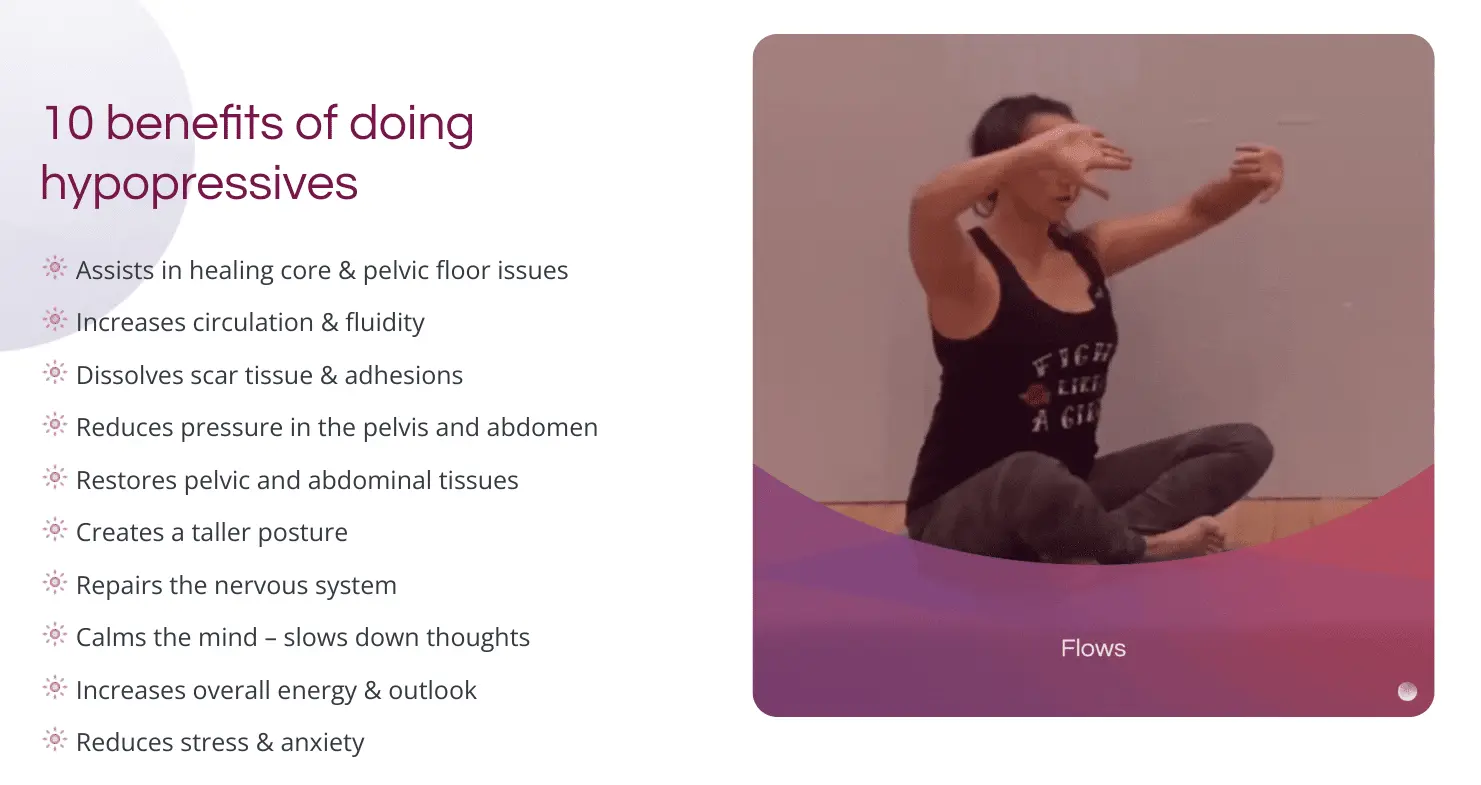I Healed Prolapse Naturally + My 8 Methods for you to try (with Video Tutorials)
- June 9, 2022
- Pelvic Floor

Healing Naturally from Pelvic Prolapse
I used to have a Grade 3 prolapse, which I reversed using natural healing methods.
So, today I am 100% symptom-free.
In this blog, I take you through not just how I healed prolapse naturally, but I also focus on the “hidden issues” that a health condition like prolapse presents.
These hidden issues can either be the biggest enablers or inhibitors of your healing.
Here’s an example of a hidden issue. Everyone around you (usually through no fault of their own, because it’s an unconscious behavior) subtly pacifies the health condition you’re facing.
In my case, my doctors, midwives, and even my dearest friends told me that pelvic floor issues are normal after giving birth. And essentially, I needed to learn to live with the issues.
After having helped hundreds of women reverse prolapse, incontinence, and other pelvic floor dysfunctions (listen to their stories here), I fully and confidently know that YOU DON’T have to “just live with it.”
Getting back to the blog…you’ll also learn about the new science no one talks about (including many doctors) when it comes to the root cause of prolapse & what methods you can use to reverse it naturally.
If you don’t have prolapse but are currently experiencing pelvic floor-related symptoms, like chafing, bulging & heaviness, leaky bladder, low libido, painful sex, vaginal wideness, and queefing, this blog article is also for you.
My Prolapse Story & how I
healed naturally
Prolapse has been on medical records since 1835 BC. Research shows that 50% of women experience pelvic organ prolapse in their lifetime. The Continence Foundation of Australia confirmed that over half of all women who had a child would suffer from prolapse. Almost half were undiagnosed due to the stigma of embarrassment.
These numbers are overwhelming. They are quite astounding because I hadn’t even heard of prolapse until I ended up having it.
“I remember shaking uncontrollably for many hours when I saw a pink “ball” protruding from my vagina. I was terrified and the chafing, bulging, and heavy feeling was horrible.”
I felt lonely and angry because I was let down by my midwives, doctors, nurses, sex-ed teachers, and even my mother.
How could none of these people warn me about this?
Sadly, no one told me because prolapse it’s a taboo topic. Embarrassment and/or low income are the primary reasons women fail to have it clinically diagnosed.
After going through my dark times, and the different stages of grief, I woke up one day feeling infuriated. Yet, this emotion made me determined to reverse the condition naturally.
Surgery side-effects for Prolapse
The choice I was going to make was always clear from the start. The medical system told me that I could try Kegels, get a pessary or have invasive surgery. But, after reading the statistics on them, I was too scared to even consider them.
I speak about the side effects of surgery in this video:
I am not against doing surgery,
but I recommend you to try ALL other options first.
I am happy to report almost two years later that I have indeed reversed my condition and live completely symptom-free.
I have done over 20 methods diligently, spent thousands of dollars, and committed my life to reverse my condition.
I am writing this blog to offer you hope out there – if you are searching for Google whether you can heal prolapse, let my journey be a reminder that yes indeed you can.
I started MoonRise because I wanted to bring such stories and methods together. I want to bring together pioneer women to offer knowledge, support, and companionship to women.
If you would rather watch this, see my YouTube video here:
What is Prolapse?
Your pelvic floor is a group of muscles and tissues and acts as a sack across your pelvic opening. Organs included are the bladder, uterus, vagina, small bowel, and rectum. Factors like pregnancy, childbirth, and aging, are the common reasons for acquiring abnormalities on your pelvic organ.
Pelvic organ disorders include pelvic organ prolapse, urinary incontinence, and anal incontinence. Prolapse is when an organ is pulled out of its normal position. Smaller prolapse is called incomplete prolapse and is often mild. Bigger prolapse is called complete prolapse and covers organs that have shifted out of their normal position and are characterized as severe.
What Are The Types of Prolapse?
Let’s explore the different types of prolapses:
1. Prolapsed Uterus
Uterine prolapse descends toward or into the vagina. An incomplete uterine prolapse is diagnosed when the uterus is partially displaced into the vagina but does not protrude. Complete uterine prolapse is diagnosed when a portion of the uterus protrudes from the vaginal opening.
2. Vaginal Vault Prolapse
When all of the organs in your vagina are in a lower position than what is considered normal, vaginal vault prolapse is diagnosed.
3. Cystocele
Cystocele is also known as anterior vaginal prolapse, the bladder is pulled from its normal position in the pelvis and pushes on the wall of the vagina. Typically, the muscles and the connective tissues on your pelvic floor, hold your pelvis, bladder, uterus, and intestines. For anterior prolapse, the pelvic floor becomes weak if there’s too much pressure.
4. Urethrocele
Urehtrocele happens when the urethra bulges into the vagina.
5. Enterocele
Also called small bowel prolapse, the small intestine descends into the lower pelvic cavity, pushes at the top part of the vagina, and creates a bulge.
6. Rectocele
Rectocele is the bulging of the front wall of the rectum into the back of the vagina. This occurs as a result of thinning and weakening of the band of tissues that separates the vagina from the rectum.
The medical system also put different grades depending on how far down the prolapse is:
• 1st grade: descended to the upper vagina
• 2nd grade: descended to the entrance
• 3rd grade: descended outside the entrance
• 4th grade: descended a bit outside the entrance
Once I realized I had a prolapse, I did not think about the degrees or grades anymore. I was determined to not carry it as a part of me into my future. I was determined to reverse it – no matter the grade & the varying symptoms I felt.
Triggers that weaken your pelvic floor
Let’s look through the most common, according to the healthcare system, triggers that can weaken your pelvic floor first:
1. Pregnancy, labor, and childbirth
If you had a long, difficult birth or gave birth to large or multiple babies, you may suffer from postpartum prolapse.
2. Obesity
Elevated BMI is a crucial lifestyle factor affecting pelvic prolapse. The increase in intra-abdominal pressure weakens your pelvic floor muscle and fascia.
3. Respiratory problems
Imagine the pelvic cavity as a balloon, in which both the diaphragm and pelvic floor are doomed together to form the balloon. Respiratory issues such as bronchial asthma, sinusitis, rhinitis, chronic bronchitis, and allergies can affect your pelvic floor.
4. Constipation
During pregnancy, an increase in the progesterone hormone causes the relaxation of your body’s muscles, specifically the intestines. A slower-moving intestine means slower digestion, thus leading to constipation. Aside from this, hemorrhoids develop and tend to remain even after childbirth. Constipation also occurs in unhealthy life choices such as inadequate fiber intake and limited physical activities resulting in pressure when passing the stool. The pressure results in the rectum’s bunching, thus the colon’s inability to move the stool forward.
5. Pelvic Organ Cancers
Cancer occurs when old or damaged cells continue to divide and multiply uncontrollably. The prognosis of pelvic cancer varies on the advancement of the disease and is associated with your age, medical history, existing conditions, and other factors. Because the pelvic area contains the reproductive organs, women can have cervical, ovarian, uterine, or endometrial, vaginal, and vulvar cancer.
6. Hysterectomy
The uterus is removed during surgery and the abdominal incision can lead to scars and even life-threatening complications. Risks include clots in the legs or lungs, blood loss, urinary retention, injury to adjacent organs, anesthesia complications, and other severe infections. Aside from those mentioned, a hysterectomy for uterine prolapse will disable women from carrying a child.
7. Menopause
Menopause is when a woman’s ovaries stop producing the essential hormones estrogen and progesterone, thus eliminating her period. This phase in a woman’s cycle is crucial for most women, and prevention accompanied by holistic treatments is vital.
Learn how to prepare and prevent menopause symptoms here.
8. Smoking
A scientific study was made, proved, and revealed that tobacco is an independent risk for pelvic organ prolapse. The results were consistent with laboratory investigations suggesting that smoking-induced activation of vaginal macrophage elastase is involved in the pathogenesis of prolapse in women who smoke.
Prolapse Root Cause – Peeling
the Onion Further
While there are many conditions that can weaken your pelvic floor, it is vital to understand the root cause of your prolapse.
1. Scar Tissue
The latest science is clear. Your prolapsed pelvic floor has been pulled out of its position due to scar tissue in your pelvic floor.
You can have scar tissue from surgeries, accidents, giving birth, rape, or any trauma that you might have experienced. In fact, Scar Tissue Massage (myofascial release) has been proven to help heal prolapse naturally, as well.
In this YouTube video, I explain the ins and outs of Scar Tissue & Prolapse:
2. Trauma
Trauma is defined as something that happened that was “too much, too fast, too soon”. In the case of trauma to the pelvis, it could be:
• An event, or experience, whether one-time/short term or long-term that applies to the pelvic area
• An event that may impact the health, longevity, resilience, and vitality of the pelvic area
• The impact may be physical, mental, emotional, spiritual, or psychological, and everything in between and with crossing-over categories
• Giving birth
• Physical Injury
• Physical Abuse
• Medical procedures
• Gender/Sexual development experiences
• Urinary system challenges (chronic UTIs, bladder leakage, kidney infections)
• Child Abuse
• Sexual abuse
• Hemorrhoids, rectal dysfunction, IBS, digestive challenges, toilet training trauma
• Abortion, miscarriage, infertility, stillbirth, infant death
Working through your trauma mentally and physically can release blocks and accelerate your healing or reversing prolapse tremendously.
Here is a video interview with Bath Shelly about how the nervous system affects a prolapse according to science:
3. Diet
70% of Americans eat processed food every day. This diet gets us nowhere. Actually, it’s the opposite of clean eating. Having this diet leads to weak muscles that your pelvis is not getting the support it needs.
If you do not give your body the nutrients it needs (especially when pregnant and giving birth) the body won’t be able to build itself back again and heal.
Collagen is one of the most important nutrients for becoming mothers and postpartum (Postpartum are up to 5 years after giving birth!). Supplements like vitamins and minerals are also crucial to support your body.
Here is a YouTube video where I speak about a diet that helped with my prolapse:
Know The Signs of Prolapse
You may not notice all the signs of prolapse, but here are some common signs:
• a lump bulging out of your vagina that you can see or feel
• disconnection to the pelvic floor and vagina
• your bladder not emptying as it should
• a heavy sensation or dragging in the vagina
• something ‘coming down’ or a lump in the vagina
• sexual problems (pain or less sensation)
• difficulty emptying your bowel
• chafing
• vaginal wideness / queefing / gas coming out of your vagina
• incontinence
Stop doing Kegels. It is most likely ineffective for you too.
Kegels work only in 1 of 5 women. The reason?
Many of us that have prolapse have scar tissues that affect our muscles, fascia & even our nerve endings.
You want to find a way to activate & strengthen your fascia to help it hold up your organs.
Having a prolapse also means you most likely have a Hypertonic pelvic floor – this indicates your pelvic floor is tense and cannot relax. Imagine having your biceps flexed all the time – that is how a hypertonic pelvic floor feels like.
Being the explosive exercise that Kegels is, this is the last thing your body needs.
Imagine a bodybuilder gets injured – would you recommend he go back to lifting weights the next day? Similarly, if you have pelvic floor weakness, you wouldn’t go do Kegels.
The advice we get from the healthcare system is about the general maintenance of our pelvic health which creates the opposite effect when you have a prolapse.
Here is a video where I explain more about this:
How to Heal Prolapse Naturally:
Some of my methods:
So to summarize, I hope you have taken away the following so far:
1. How shockingly common prolapse is
2. Triggers that cause it
3. The root cause, especially around scar tissue, diet & trauma
4. Knowing the signs of prolapse
5. And why Kegels is not effective
This leads me to the last section where I introduce some of the methods that have worked for me. I believe there is no 1 size that fits all – some of these methods might or might not work for you.
However, the key to healing is to believe that you can and have an attitude to try these methods with self-discipline.
The holistic approach focuses on the interconnection of your body and mental perception. Believe in achieving. Here are the best natural prolapse treatments.
1. Hypopressives
Hypopressives or the Hypopressive method is a series of breathing and postural exercises. They improve pelvic floor health as well as core functionality.
Here is a free video to get started from my YouTube:
2. Pelvic floor relaxation
Learning how to relax your pelvic floor is key, especially if you have a Hypertonic Pelvic Floor.
Here is a YouTube video that can help you get started with a simple meditation for your pelvic issues:
3. Scar Tissue Remediation
Typically, collagen has very organized patterns, and with the presence of elastin molecules, it will lodge as it is unless severed by trauma. Due to elastin trauma, the collagen molecules resolve into adhering to the adjacent tissue. trauma, surgery, childbirth, trauma. Learn more about Scar Tissue Remediation here.
4. Belly Dancing
Ten minutes of belly dance-inspired hip movements can help strengthen your pelvic floor. Here is a study about it especially if you suffer from incontinence.
5. Clean-eating
Clean-eating is similar to how our forefathers ate before the advent of processed food. Adding collagen can be truly beneficial to your healing. Here is a study that links the benefit of collagen to reversing prolapse.
In this video I show you exactly what to eat for healing prolapse:
6. Essential Oils
Finding the essence that will help you connect inwards.
In this video, I show you exactly how:
7. Vaginal Steaming
Practiced since the dawn of mankind, this ancient technique is making a big comeback into the world of self-care & healing as women from around the world discover the benefits of using herbs & steaming.
Note: there are a lot of women that spread fear regarding steaming. I personally think this technique has been crucial in my healing journey.
Here is a YouTube video where I take you through the basics:
8. Visualization techniques
The biggest secret to reversing my prolapse was actually my growing belief that this prolapse is not part of me and I am going to leave it behind to go on with my life.
Positive affirmations, meditations & visualization techniques were vital for me to be where I am today.
Here are 2 videos that can help you get started:
https://youtu.be/aKGTYQUvrBAhttps://youtu.be/VeJfrVHu8kA
You can ask me a question by sending us an email at support@moonrise.health or chat with us!
I hope this blog gives you inspiration and hope that you can indeed reverse prolapse naturally. I am your living example along with all my teachers & women in our community.
MoonRise has your back!
Our community is for any and every woman looking for a safe space to be seen, heard, and validated.
Check out my Pelvic Floor Dysfunction Program or my Hypopressives Exercise Course and get started with your healing today!
Blog posts you might like:






